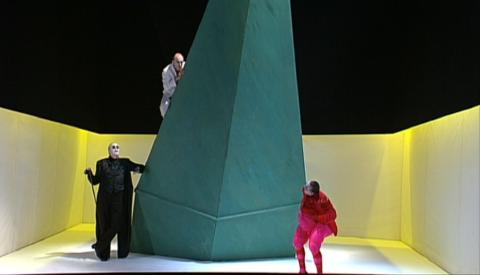This
semester in Music History: Contemporary has been chalk full of a wide variety
of music, ranging from symphonies to jazz to movie scores. I can honestly say that, before this class, I
hadn’t heard most of this music. While
much of it was unique and interesting enough to make a lasting impression in my
mind, one work really sticks out in my brain.
The composer Alban Berg and his opera Wozzeck was an experience unlike one I had ever had, and I believe I
will remember it long after this class is completed and over.
I
think that the main reason this work sticks with me is because of how
uncomfortable it made me feel when I watched it. As I said before, it wasn’t like anything I had
encountered before. I personally like my
opera tonal, with beautiful costumes and sets, and making sense. I could not find any of these characteristics
in the opera Wozzeck when I first watched it. Going back to my blog from the Berg week, I wrote
The very first time I had ever heard Berg’s Wozzeck
was on Monday afternoon when I watched a performance of it in the listening
room upstairs in Jensen. I can only
imagine what my face must have looked like throughout the hour and 40 minutes
of the opera. This opera is unlike
anything I have ever heard or seen before in my 21 years of life. Without any background information on the
work, I was at a complete loss as to how this positions itself into my musical
world.
The costumes were very minimal and simple. They were clothing that I’ve seen people wear
before, and yet there was something disconcerting about them. The child of Wozzeck and Marie wore a white
mask the whole time, which from beginning to end creeped me out.


The set was even more unusual and unconventional. It felt like the entire stage was a giant box
the actors were in. The ground they
walked on was moveable, huge and rolled out as the scene changed. The set designers used abnormal shapes for
things. Marie’s house was bright red,
but only the size of a dog house.
Sometimes a wooden floor hung down from wires and swayed back and forth,
with people on it acting out scenes. One
scene, with the doctor, Wozzeck’s employer, and Wozzeck, there is a tower that they
can climb up; instead of it just being a tower, however, it’s a giant pyramid.


The music and
plot line were very distressing to me as well.
One scene in particular that I remember is scene 4, when Wozzeck goes to
visit the doctor. It is in this scene
that the audience finds out Wozzeck has been part of bizarre medical
experiments with outrageous rules, like not being allowed to cough, and a rigid
diet that must be followed. Wozzeck can’t
stop coughing though, and this angers the doctor. Wozzeck goes into what the synopsis of the
opera describes as “an outburst of hallucinatory insanity.” The doctor is very happy about this, and
believes that he will become famous with his discoveries with Wozzeck. The music that coincides this scene sounds
sinister and a little fantastical, especially as Wozzeck goes into his
outburst. It is obvious that something
bad is happening during this scene just by listening to the music. The idea of a doctor purposely making his
patient go crazy is disturbing, and yet that is what the premise of the opera
is.
Another
scene that is unsettling is the last scene of the opera. This is the morning after Wozzeck kills his
wife and then dies himself. Their child
is outside playing with the other children, when another child runs up and says
that his mother is dead, but the child doesn’t seem to understand. He continues to play on his horse as the other
children all run away to the pond. The
music during this scene has a childlike quality to it, and yet puts a chill
down my spine when I listen to it. The
innocence of the children singing is ruined by the orchestra underneath it, and
the overall tone of the final scene is, well, creepy.
For all of
the spine tingling moments of the opera, there was one part of it that I really
enjoyed listening to: Marie’s Cradle Song from Act 1. I thought that this was a beautiful part of a
very harsh-sounding opera. We looked at
this particular song a little more in depth in class that week. There are tonal aspects to the piece that
create the softer sounds. Quartal and
quintal harmonies are found in this song, along with simplistic harmony, like a
chord in one measure. Marie is singing a
lullaby to her child, and it is a pretty moment in the opera.
Overall,
this opera by Berg is one that will stick with me for a long time. I didn’t even know that things like this work
existed before watching Wozzeck. While it’s not something I think I would ever
want to watch again, it definitely held my attention throughout the entire
show, and kept me interested. While a
lot of music we listened to this semester did this, nothing struck a chord in
me quite like Berg’s Wozzeck.